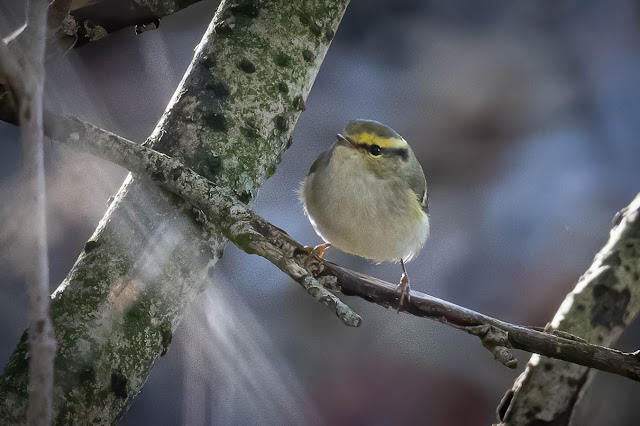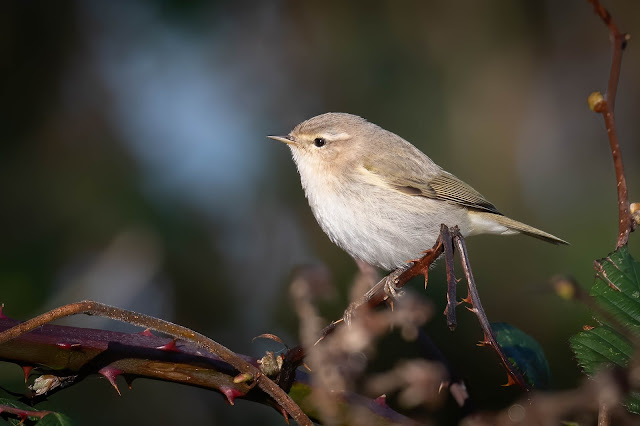I've got three local county outings that I thought I would amalgamate into a single blog post. One of them was a county first that mobilised the entire Oxon birding community en masse but we'll come to that in a while.
Diver
My first outing was a trip to Farmoor a few weekends back to pay homage to the long staying juvenile Great Northern Diver that is spending the winter there. This bird has been around for a while now and clearly is finding it to its liking. There have been countless photos of it dismembering the invasive Signal Crayfish that are so prolific in our waters these days. On the day that I went it was right in the far north west corner of F1 and despite trying to see it from across the other side, it was only when I actually walked all the way around that I was able to find it. The light was very overcast by then so my record shots have come out rather monotonic but still it was very nice to see such a smart and impressive bird comparatively close up and looking so relaxed and at home.
 |
| The over-wintering juvenile Great Norther Diver |
County First!
The next outing took place a couple of weeks ago. News broke late one afternoon of a Pallas' Warbler that had been found at Abingdon sewage works by GB. The back of camera shots were suitably gripping and whilst the news broke too late for me to contemplate a twitch I understand that a couple of people did actually manage it in the 30 minute window before dusk.
Pallas' Warbler are usually found on the east coast in autumn and inland birds are very rare. I remember twitching my first one in Berkshire back in 2013 when one over-wintered along a river on the Berkshire/Hampshire border. Since then, I have seen three more: Cornwall (self-found!), Spurn (briefly) and Norfolk (fantastic views at Thornham) so in terms of my national listing this was not particularly important. However, in terms of Oxon listing there was no doubting the significance of this find as it was a county first. This meant that all the serious county twitchers were going to be there the next day and naturally enough I was going to try to see it too.
Overnight it was ridiculously cold, going down to a freezing -5 degrees. This made me wonder whether being there at first light was actually the best tactic or whether to wait a little bit until things warmed up a little might not be better. So in the end I rocked up at the sewage works at a little after 9 a.m. to find the great and the good of the county birding world all assembled already: they'd all been there since first light of course, being proper hardcore twitchers. Still it hadn't done them any good as there'd been no sign of it so far. In fact it had just got to the stage where intense concentration in looking for the target was starting to wane and was giving way to aimiable chatting instead. It was quite something to see everyone all there together. Since the pandemic there hadn't been a chance for any social gatherings in the Oxon birding world so for many this was a good chance for a long overdue catch up.
Having come a bit later I was still quite keen and diligently searched along the northern boundary of the treatment works for the target bird. There were plenty of Chiffchaffs about and one or two Goldcrest which would get the pulse racing until the head was seen properly but not our much sought after county first. After about 30 minutes of this a shout went up to the west. We all knew what this meant and as one we hurried to investigate. It turned out that PR had seen it briefly in a more wooded area off to the north west of the works. We all spread out looking and a minute or two later PR had it again in a tree next to the path. We all converged on the spot and sure enough there it was, zipping about high up in an Alder tree. It was hard to pin down as it was very active but I managed to see it well enough to be sure of what I was looking at. We then all followed it for several minutes as it worked its way through the tree tops before it went deeper into the wood and was lost to view.
After that, the atmosphere relaxed noticeably. There was a lot of chatting and mutual back slapping and comparing back of camera photos from those that had managed to get off a shot. The crowd also began to disperse, with some of those who'd been there since first light starting to head off home. A few late comers arrived to find that always difficult twitching situation where everyone there has seen it well and is no longer looking and you're left trying to refind it on your own. For myself, having arrived a bit later and having seen the bird comparatively quickly I was in no particular hurry to leave. I wandered back to the main sewage work area for a bit to take a look at the Siberian Chiffchaffs which tended to hang out at this area. They see to be faithful to a small area next to the concrete treatment rings and I saw them well enough. I then helped some of the late arrivals to look for the bird again but without any success. Eventually hunger started to get the better of me and I headed back for home with a shiny new county tick to my name.
 |
| Some of the lingering twitchers watching the Siberian Chiffies |
 |
| A couple of stunning photos of the Pallas' Warbler taken a few days later, courtesy of Roger Wyatt |
Pallas' Revisited and a Duck
I didn't stay too long as the views were unlikely to get better and there was no point in attempting a photo given the distances, the gloomy light and how comparatively elusive the bird was. Instead I chose to nip over to Thrupp lake nearby at Radley to see the drake Ring-necked Duck. It was immediately on view though somewhat distant. I busied myself with trying to photograph it but given the circumstances it was always just going to be a record shot. Also present on the lake were seven Red-crested Pochard, a species that I don't happen to see that often. There is a bit of a glut of RND's nationally at the moment and it's nice to see that Oxfordshire is getting in on this action. Indeed just in Oxon, apart from this bird there is a lingering female at Appleford GPs which is being seen from time to time.
 |
| A photo of the distant Ring-necked Duck |






























